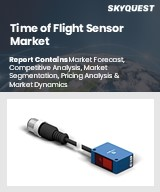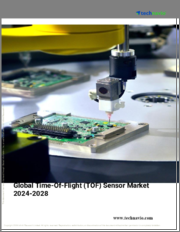
|
시장보고서
상품코드
1796437
비행 시간 센서 시장 규모, 점유율, 성장 분석 : 제품별, 조직 규모별, 용도별, 최종사용자별, 지역별 - 산업 예측(2025-2032년)Time of Flight Sensor Market Size, Share, and Growth Analysis, By Product (Range-Gated Sensors, Light Detection and Ranging (LiDAR) Sensors), By Organization Size, By Application, By End user, By Region - Industry Forecast 2025-2032 |
||||||
세계의 비행 시간 센서 시장 규모는 2023년에 55억 달러로 평가되며, 2024년 63억 3,000만 달러에서 2032년에는 193억 5,000만 달러로 성장하며, 예측 기간(2025-2032년)의 CAGR은 15%로 성장할 전망입니다.
세계의 비행시간(ToF) 센서 시장은 급속한 기술 발전, 자동화에 대한 정부 투자 증가, 첨단 심도 센싱 기술에 대한 소비자의 선호도 변화로 인해 강력한 성장세를 보이고 있습니다. 각국 정부는 스마트 제조, 디지털 전환, 산업 자동화, 스마트 시티 구상 등 다양한 분야에 걸쳐 3D 센싱 솔루션을 통합하는 데 주력하고 있습니다. ToF 센서가 머신러닝 및 엣지 컴퓨팅과 융합하여 공간 데이터 수집을 강화하고 컨텍스트를 고려한 활용을 가능하게 함으로써 큰 기술 혁신이 일어나고 있습니다. 에너지 효율이 높은 소형 ToF 모듈의 추세는 휴대용 장치의 전력 소비를 줄임으로써 지속가능성 목표를 지원합니다. 또한 AI의 통합으로 ToF 센서의 기능이 강화되어 교통, 보안 등의 분야에서 실시간 적응 및 지능형 데이터 처리가 가능해집니다.
목차
서론
- 조사의 목적
- 조사 범위
- 정의
조사 방법
- 정보 조달
- 1차와 2차 데이터 방법
- 시장 규모 예측
- 시장의 전제조건과 제한
개요
- 세계 시장 전망
- 공급과 수요 동향 분석
- 부문별 기회 분석
시장 역학과 전망
- 시장 개요
- 시장 규모
- 시장 역학
- 촉진요인과 기회
- 억제요인과 과제
- Porter의 산업 분석
주요 시장 인사이트
- 주요 성공 요인
- 경쟁의 정도
- 주요 투자 기회
- 시장 에코시스템
- 시장의 매력 지수(2024년)
- PESTEL 분석
- 거시경제 지표
- 밸류체인 분석
- 가격 분석
- 기술 분석
- 사용 사례
비행 시간 센서 시장 규모 : 제품별 & CAGR(2025-2032년)
- 시장 개요
- 레인지 게이트 센서
- LiDAR(Light Detection and Ranging) 센서
- 3D ToF 카메라
비행 시간 센서 시장 규모 : 조직 규모별 & CAGR(2025-2032년)
- 시장 개요
- 대기업과 중견 기업
- 중소기업
비행 시간 센서 시장 규모 : 용도별 & CAGR(2025-2032년)
- 시장 개요
- 제스처 인식
- 거리 측정
- 3D 이미징
- 물체 탐지
비행 시간 센서 시장 규모 : 최종사용자별 & CAGR(2025-2032년)
- 시장 개요
- 가전제품
- 자동차
- 산업
- 헬스케어
- 항공우주와 방위
- 로봇 공학
비행 시간 센서 시장 규모 & CAGR(2025-2032년)
- 북미
- 미국
- 캐나다
- 유럽
- 독일
- 스페인
- 프랑스
- 영국
- 이탈리아
- 기타 유럽
- 아시아태평양
- 중국
- 인도
- 일본
- 한국
- 기타 아시아태평양
- 라틴아메리카
- 브라질
- 기타 라틴아메리카
- 중동 및 아프리카
- GCC 국가
- 남아프리카공화국
- 기타 중동 및 아프리카
경쟁 정보
- 상위 5사의 비교
- 주요 기업의 시장 포지셔닝(2024년)
- 주요 시장 기업이 채택한 전략
- 최근 시장 동향
- 기업의 시장 점유율 분석(2024년)
- 주요 기업의 기업 개요
- 기업의 상세
- 제품 포트폴리오 분석
- 기업의 부문별 점유율 분석
- 매출의 전년대비 비교(2022-2024년)
주요 기업 개요
- Texas Instruments, Inc.
- STMicroelectronics N.V.
- Infineon Technologies AG
- Sony Corporation
- Panasonic Corporation
- Ams AG
- Melexis NV
- Keyence Corporation
- Teledyne Technologies Incorporated
- pmdtechnologies ag
- Sharp Corporation
- Broadcom, Inc.
- Omron Corporation
- Renesas Electronics Corporation
- ESPROS Photonics Corporation
결론과 제안
KSA 25.08.29Global Time of Flight Sensor Market size was valued at USD 5.50 Billion in 2023 and is poised to grow from USD 6.33 Billion in 2024 to USD 19.35 Billion by 2032, growing at a CAGR of 15% in the forecast period (2025-2032).
The global market for time of flight (ToF) sensors is experiencing robust growth due to rapid technological advancements, increased government investments in automation, and evolving consumer preferences for advanced depth-sensing technologies. Governments are focusing on smart manufacturing, digital transformation, and the integration of 3D sensing solutions across various sectors, including industrial automation and smart city initiatives. Significant technological innovations are occurring as ToF sensors converge with machine learning and edge computing, enhancing spatial data acquisition and enabling context-aware applications. The trend toward energy-efficient and compact ToF modules supports sustainability goals by reducing power consumption in portable devices. Additionally, the integration of AI enhances ToF sensor functionality, allowing for real-time adaptation and intelligent data processing across sectors like transportation and security.
Top-down and bottom-up approaches were used to estimate and validate the size of the Global Time of Flight Sensor market and to estimate the size of various other dependent submarkets. The research methodology used to estimate the market size includes the following details: The key players in the market were identified through secondary research, and their market shares in the respective regions were determined through primary and secondary research. This entire procedure includes the study of the annual and financial reports of the top market players and extensive interviews for key insights from industry leaders such as CEOs, VPs, directors, and marketing executives. All percentage shares split, and breakdowns were determined using secondary sources and verified through Primary sources. All possible parameters that affect the markets covered in this research study have been accounted for, viewed in extensive detail, verified through primary research, and analyzed to get the final quantitative and qualitative data.
Global Time of Flight Sensor Market Segments Analysis
The global time-of-flight sensor market is segmented based on product type, application, organization size, end user, and region. By product type, the market is classified into range-gated sensors, light detection and ranging (LiDAR) sensors, and 3D ToF cameras. Depending on organization size, it is divided into large and medium enterprises and small enterprises. According to the application, the market is divided into gesture recognition, distance measurement, 3D imaging, and object detection. As per end user, it is categorized into consumer electronics, automotive, industrial, healthcare, aerospace & defense, and robotics. Regionally, the market is analyzed across North America, Europe, Asia-Pacific, Latin America, and the Middle East and Africa.
Driver of the Global Time of Flight Sensor Market
One of the key market drivers for the global Time of Flight (ToF) sensor market is the rising demand for advanced imaging and sensing technologies across various applications, including consumer electronics, automotive, and healthcare. The proliferation of smartphones and smart devices, which increasingly incorporate ToF sensors for functionalities such as facial recognition, augmented reality, and depth sensing, significantly boosts market growth. Additionally, the automotive sector is leveraging ToF sensors for enhanced safety features, automated driving systems, and obstacle detection. This growing integration of ToF sensors in diverse sectors underscores their importance in facilitating innovative solutions and improving user experiences.
Restraints in the Global Time of Flight Sensor Market
One key market restraint for the Global Time of Flight Sensor Market is the high cost of advanced sensor technologies. The implementation of time of flight (ToF) sensors often requires substantial investment in research and development, manufacturing infrastructure, and integration with existing systems. This financial barrier can deter small and medium-sized enterprises from adopting these advanced technologies, thus slowing overall market growth. Additionally, fluctuating raw material prices can impact production costs, further complicating market dynamics. As a result, the economic constraints associated with high-quality ToF sensor deployment may limit market penetration and reduce potential customer adoption rates.
Market Trends of the Global Time of Flight Sensor Market
The Global Time of Flight (ToF) Sensor market is witnessing a transformative trend driven by the integration of AI and edge computing technologies. This synergy enables real-time, on-device decision-making, thereby significantly reducing latency across various applications, including smart surveillance, gesture recognition, and automotive systems. As demand surges in consumer electronics and autonomous systems, ToF sensors are expanding their use cases, enhancing operational speed, privacy, and energy efficiency. This evolution not only boosts performance but also aligns with the growing emphasis on intelligent and responsive technologies, positioning ToF sensors as critical components in next-generation applications across diverse industries.
Table of Contents
Introduction
- Objectives of the Study
- Scope of the Report
- Definitions
Research Methodology
- Information Procurement
- Secondary & Primary Data Methods
- Market Size Estimation
- Market Assumptions & Limitations
Executive Summary
- Global Market Outlook
- Supply & Demand Trend Analysis
- Segmental Opportunity Analysis
Market Dynamics & Outlook
- Market Overview
- Market Size
- Market Dynamics
- Drivers & Opportunities
- Restraints & Challenges
- Porters Analysis
- Competitive rivalry
- Threat of substitute
- Bargaining power of buyers
- Threat of new entrants
- Bargaining power of suppliers
Key Market Insights
- Key Success Factors
- Degree of Competition
- Top Investment Pockets
- Market Ecosystem
- Market Attractiveness Index, 2024
- PESTEL Analysis
- Macro-Economic Indicators
- Value Chain Analysis
- Pricing Analysis
- Technology Analysis
- Case Studies
Global Time of Flight Sensor Market Size by Product & CAGR (2025-2032)
- Market Overview
- Range-Gated Sensors
- Light Detection and Ranging (LiDAR) Sensors
- 3D ToF Cameras
Global Time of Flight Sensor Market Size by Organization Size & CAGR (2025-2032)
- Market Overview
- Large & Medium Enterprises
- Small Enterprises
Global Time of Flight Sensor Market Size by Application & CAGR (2025-2032)
- Market Overview
- Gesture Recognition
- Distance Measurement
- 3D Imaging
- Object Detection
Global Time of Flight Sensor Market Size by End User & CAGR (2025-2032)
- Market Overview
- Consumer Electronics
- Automotive
- Industrial
- Healthcare
- Aerospace & Defense
- Robotics
Global Time of Flight Sensor Market Size & CAGR (2025-2032)
- North America (Product, Organization Size, Application, End User)
- US
- Canada
- Europe (Product, Organization Size, Application, End User)
- Germany
- Spain
- France
- UK
- Italy
- Rest of Europe
- Asia Pacific (Product, Organization Size, Application, End User)
- China
- India
- Japan
- South Korea
- Rest of Asia-Pacific
- Latin America (Product, Organization Size, Application, End User)
- Brazil
- Rest of Latin America
- Middle East & Africa (Product, Organization Size, Application, End User)
- GCC Countries
- South Africa
- Rest of Middle East & Africa
Competitive Intelligence
- Top 5 Player Comparison
- Market Positioning of Key Players, 2024
- Strategies Adopted by Key Market Players
- Recent Developments in the Market
- Company Market Share Analysis, 2024
- Company Profiles of All Key Players
- Company Details
- Product Portfolio Analysis
- Company's Segmental Share Analysis
- Revenue Y-O-Y Comparison (2022-2024)
Key Company Profiles
- Texas Instruments, Inc.
- Company Overview
- Business Segment Overview
- Financial Updates
- Key Developments
- STMicroelectronics N.V.
- Company Overview
- Business Segment Overview
- Financial Updates
- Key Developments
- Infineon Technologies AG
- Company Overview
- Business Segment Overview
- Financial Updates
- Key Developments
- Sony Corporation
- Company Overview
- Business Segment Overview
- Financial Updates
- Key Developments
- Panasonic Corporation
- Company Overview
- Business Segment Overview
- Financial Updates
- Key Developments
- Ams AG
- Company Overview
- Business Segment Overview
- Financial Updates
- Key Developments
- Melexis NV
- Company Overview
- Business Segment Overview
- Financial Updates
- Key Developments
- Keyence Corporation
- Company Overview
- Business Segment Overview
- Financial Updates
- Key Developments
- Teledyne Technologies Incorporated
- Company Overview
- Business Segment Overview
- Financial Updates
- Key Developments
- pmdtechnologies ag
- Company Overview
- Business Segment Overview
- Financial Updates
- Key Developments
- Sharp Corporation
- Company Overview
- Business Segment Overview
- Financial Updates
- Key Developments
- Broadcom, Inc.
- Company Overview
- Business Segment Overview
- Financial Updates
- Key Developments
- Omron Corporation
- Company Overview
- Business Segment Overview
- Financial Updates
- Key Developments
- Renesas Electronics Corporation
- Company Overview
- Business Segment Overview
- Financial Updates
- Key Developments
- ESPROS Photonics Corporation
- Company Overview
- Business Segment Overview
- Financial Updates
- Key Developments
















